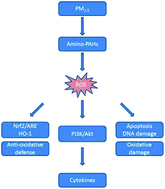当前位置:
X-MOL 学术
›
Toxicol. Res.
›
论文详情
Our official English website, www.x-mol.net, welcomes your
feedback! (Note: you will need to create a separate account there.)
Amino-PAHs activated Nrf2/ARE anti-oxidative defense system and promoted inflammatory responses: the regulation of PI3K/Akt pathway
Toxicology Research ( IF 2.2 ) Pub Date : 2018-03-16 00:00:00 , DOI: 10.1039/c8tx00010g Meiying Wu 1, 2, 3, 4 , Yuting Jiang 1, 2, 3, 4 , Mingyuan Liu 4, 5, 6, 7, 8 , Yu Shang 1, 2, 3, 4 , Jing An 1, 2, 3, 4
Toxicology Research ( IF 2.2 ) Pub Date : 2018-03-16 00:00:00 , DOI: 10.1039/c8tx00010g Meiying Wu 1, 2, 3, 4 , Yuting Jiang 1, 2, 3, 4 , Mingyuan Liu 4, 5, 6, 7, 8 , Yu Shang 1, 2, 3, 4 , Jing An 1, 2, 3, 4
Affiliation

|
The amino polycyclic aromatic hydrocarbons (amino-PAHs) were frequently detected in PM2.5, and it was suggested that they contributed to the harmful health effects associated with PM2.5. However, the process through which amino-PAHs induce oxidative stress responses as well as the pro-inflammatory processes along with the associated mechanisms is still not well-known. In this study, oxidative stress level, Nrf2/ARE anti-oxidative defense responses, oxidative damages and cytokine expressions were investigated in the A549 cell line after it was treated with typical airborne amino-PAHs including 1-aminopyrene (1-AP) and 3-aminofluoranthene (3-AF). The possibility of the phosphatidylinositol 3-kinase (PI3K)/protein kinase B (Akt) pathway participating in the regulation of cytokine gene expression was also considered, and the study was conducted accordingly. The results showed that 1-AP and 3-AF in a dose-dependent manner could cause extensive damages including cell apoptosis, cell cycle arrests, and DNA damages and could up-regulate the TNF-α gene expression. In addition, the Nr2/ARE defense system was activated, as evidenced by the increased protein expression levels and nuclear translocation of Nrf2. The Nrf2/ARE binding activity was elevated and was measured with the EMSA method. Also, the protein of heme oxygenase-1 (HO-1) was up-regulated. Finally, an increase in the protein expressions of the DNA-dependent protein kinase catalytic subunit (DNA-PKcs) and phosphorylation levels of Akt was observed, indicating that the PI3K/Akt pathway was activated. Furthermore, both LY294002 (an inhibitor of PI3K) and MK-2206 (an inhibitor of Akt) could significantly decrease the elevated TNF-α gene expressions, suggesting that the PI3K/Akt pathway was involved in the regulation of TNF-α expressions induced by 1-AP and 3-AF. Our results further confirmed that amino-PAHs could be a particularly important PAH derivatives contributing to the health risks caused by PM2.5.
中文翻译:

氨基PAHs激活Nrf2 / ARE抗氧化防御系统并促进炎症反应:PI3K / Akt途径的调节
在PM 2.5中经常检测到氨基多环芳烃(amino-PAHs),这表明它们有助于与PM 2.5相关的有害健康影响。但是,氨基-PAHs诱导氧化应激反应的过程以及促炎过程以及相关机制仍不为人所知。在这项研究中,研究了A549细胞系中的氧化应激水平,Nrf2 / ARE抗氧化防御反应,氧化损伤和细胞因子表达,并用包括1-氨基py(1-AP)和3的典型机载氨基PAHs处理了A549细胞系。 -氨基荧蒽(3-AF)。还考虑了磷脂酰肌醇3-激酶(PI3K)/蛋白激酶B(Akt)途径参与细胞因子基因表达调控的可能性,并据此进行了研究。结果表明,1-AP和3-AF可能以剂量依赖性方式引起广泛的损害,包括细胞凋亡,细胞周期停滞,和DNA损伤,并可能上调TNF-α基因的表达。此外,Nr2 / ARE防御系统被激活,这由Nrf2的蛋白表达水平增加和核易位证明。Nrf2 / ARE结合活性提高,并通过EMSA方法进行测量。另外,血红素加氧酶-1(HO-1)的蛋白也被上调。最后,观察到DNA依赖性蛋白激酶催化亚基(DNA-PKcs)的蛋白表达和Akt的磷酸化水平增加,表明PI3K / Akt途径被激活。此外,LY294002(PI3K的抑制剂)和MK-2206(Akt的抑制剂)均可显着降低升高的TNF-α基因表达,这表明PI3K / Akt途径参与了由TNF-α诱导的TNF-α表达的调节。 1-AP和3-AF。2.5。
更新日期:2018-03-16
中文翻译:

氨基PAHs激活Nrf2 / ARE抗氧化防御系统并促进炎症反应:PI3K / Akt途径的调节
在PM 2.5中经常检测到氨基多环芳烃(amino-PAHs),这表明它们有助于与PM 2.5相关的有害健康影响。但是,氨基-PAHs诱导氧化应激反应的过程以及促炎过程以及相关机制仍不为人所知。在这项研究中,研究了A549细胞系中的氧化应激水平,Nrf2 / ARE抗氧化防御反应,氧化损伤和细胞因子表达,并用包括1-氨基py(1-AP)和3的典型机载氨基PAHs处理了A549细胞系。 -氨基荧蒽(3-AF)。还考虑了磷脂酰肌醇3-激酶(PI3K)/蛋白激酶B(Akt)途径参与细胞因子基因表达调控的可能性,并据此进行了研究。结果表明,1-AP和3-AF可能以剂量依赖性方式引起广泛的损害,包括细胞凋亡,细胞周期停滞,和DNA损伤,并可能上调TNF-α基因的表达。此外,Nr2 / ARE防御系统被激活,这由Nrf2的蛋白表达水平增加和核易位证明。Nrf2 / ARE结合活性提高,并通过EMSA方法进行测量。另外,血红素加氧酶-1(HO-1)的蛋白也被上调。最后,观察到DNA依赖性蛋白激酶催化亚基(DNA-PKcs)的蛋白表达和Akt的磷酸化水平增加,表明PI3K / Akt途径被激活。此外,LY294002(PI3K的抑制剂)和MK-2206(Akt的抑制剂)均可显着降低升高的TNF-α基因表达,这表明PI3K / Akt途径参与了由TNF-α诱导的TNF-α表达的调节。 1-AP和3-AF。2.5。











































 京公网安备 11010802027423号
京公网安备 11010802027423号